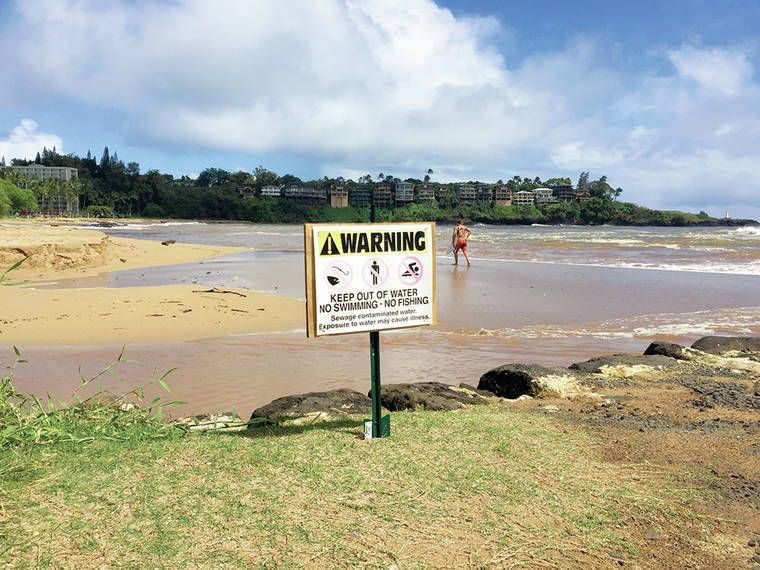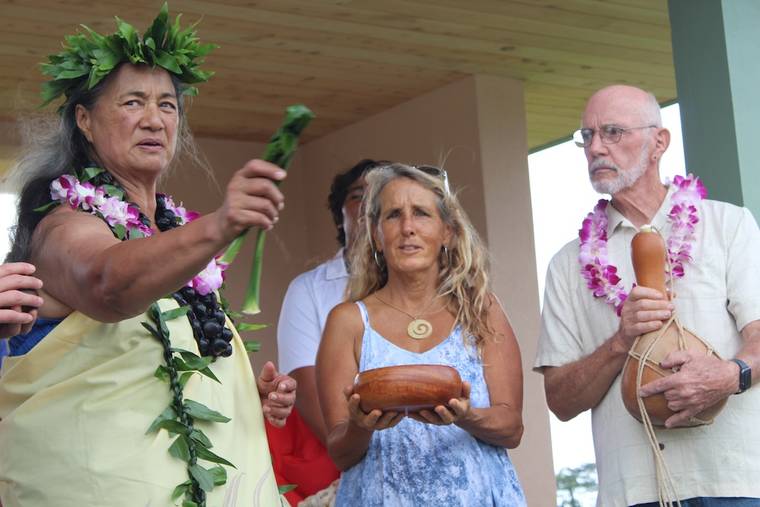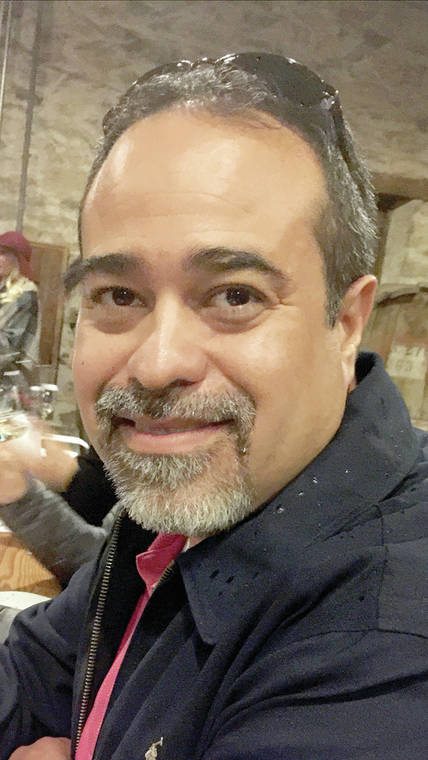LIHU‘E — Traces of the artificial sweetener sucralose have been found in 20 streams and four rivers on Kaua‘i, and some scientists say it could mean cesspools and septic systems on the island are leaking into those streams and rivers.
Volunteers with the Kaua‘i Chapter of Surfrider Foundation Blue Water Task Force reported the findings in their April announcement of water-quality results from samples taken monthly from river mouths and surf spots around the island.
The BWTF is headed up by John Alderete, and was led for years by Kaua‘i resident Carl Berg, current senior scientist for Surfrider Kaua‘i.
Berg said he and Alderete have been checking bacteria and virus levels in water for 14 years.
There are other Surfrider chapters on the other islands in the state, and over 80 chapters nationwide.
“We all measure the same thing, which is the bacteria (acceptable levels) that the EPA recommends, and the state of
Hawai‘i has said (it) is their standard for indicating that the waters are polluted,” Berg said.
“So it’s what we’re looking at is a single kind of bacteria enterococcus. And that’s all we test for, because that’s what the state of Hawai‘i tests for. We don’t test where the Department of Health tests. We test all the other places.
“And, mainly, we test the streams and rivers and also the surf sites out where the surfers actually play, because we’re the Surfrider Foundation,” Berg said.
In April, the BWTF reported above-average bacteria levels in 12 of the 17 sites that were sampled.
And BWTF scientists said they also found the chemical sucralose during their testing process, a chemical that is found in processed foods like bagels, or as a sweetener in coffee.
While Alderete and Berg say the presence of sucralose is an indicator of potential cesspool leaking, it could also come from recycled golf-course water or from pig farms that feed livestock processed human foods.
“Based upon the testing that Kaua‘i Chapter of Surfrider has done, there are concerns that the antiquated cesspools and non-compliant septic systems near the streams or near the ocean may be polluting those bodies of water,” Berg said leaking “into the groundwater into the streams and rivers, then onto the beach, and then into the ocean.”
The goal is to identify those systems and get them replaced as soon as possible, they said.
There are about 13,698 cesspools on Kaua‘i and an estimated 88,000 active cesspools statewide, the majority of which are small-capacity cesspools, regulated by the stateDepartment of Health.
Small-capacity cesspools are not banned under U.S. law, but the federal Environmental Protection Agency banned the construction of new, large-capacity cesspools (LCCs) in 2000, and required existing LCCs to be closed no later than April 5, 2005.
Amy Miller, EPA Pacific Southwest regional director of enforcement and compliance assurance, said EPA is concerned about the impacts of cesspools on human health and the environment in Hawai‘i, where groundwater provides 95% of all domestic water and where cesspools are used more widely than in any other state.
She said since EPA’s 2005 federal LCC ban, more than 3,400 LCCs (689 LCCs on Kaua‘i) have been closed statewide voluntarily by owners or via EPA enforcement activities.
The EPA continues to conduct enforcement to target and close LCCs, but given the challenges to finding them, EPA encourages all landowners, including state agencies, to help identify more LCCs by conducting voluntary compliance audits.
“Release of raw, untreated sewage to a cesspool can contaminate oceans, streams and groundwater by releasing disease-causing pathogens and nitrates,” Miller said.
“Bacteria and viruses found in such cesspool sewage can impact human health through drinking or swimming in contaminated water. Nitrates can damage land or aquatic ecosystems, including coral reefs.
State DOH Wastewater Branch Chief Sina Pruder pointed out that cesspools inject about 40 million gallons of raw sewage a day into Hawai‘i’s groundwater, “contaminating drinking-water sources, streams and oceans with disease-causing pathogens.”
“The discharge of raw sewage is also impacting the coral reef,” Pruder said.
To mitigate those impacts, DOH has established a cesspool-conversion working group to develop a long-range, comprehensive plan for cesspool conversion statewide for all cesspools by 2050.
Stuart Coleman, executive director and founder of the Hawai‘i nonprofit Wastewater Alternatives &Innovations, said Hawai‘i has the most cesspools per capita of any state in the country.
“We just can’t ignore it any longer, because there are human and environmental health threats,” Coleman said. “And it could also affect the bottom line of tourists, if people, you know, find out our waters are polluted.”
•••
Stephanie Shinno, education and business reporter, can be reached at 245-0424 or sshinno@thegardenisland.com.








Why is it so difficult to find the cesspools? Simply enact a law requiring every property owner to investigate and disclose the type and condition of their septic system. Set large fines and strong criminal penalties for noncompliance that will pay for enforcement activities.
Check out HanaleiWaiWai.org to see the current cesspool map for north county
M There is nothing illegal about a Cesspool. They are shafts and enclosures that go down very deep into the earth. Most of anything harmful is naturally filtered by the earth, rocks, sand and other substrata it has to filter through as it travels anywhere. The rest feeds the plants and trees etc. Does a small portion of pollution reach our waters, undoubtedly, Do we need technology to make them, anything, 100% pure? Yes. Go invent that and you’ll be able to support humanity and yourself for a while.
Actually my husband and his company has invented a solution and spent hundreds of thousands of dollars and patents developing it. But the state of hawaii government is so corrupt they won’t accept it. There is a “task force” where it is literally their full time job to come up with a solution, but guess what? When they come up with a solution they are out of work! So they don’t return calls, even though my husband has handed everything to them on a silver platter.
So we just continue seeing all these reports of Hawaii soon not having clean drinking water while we have a solution right here ready and are being completely ignored. And yes, we have reached out to all these “surf rider” organizations and news outlets trying to bring it to their attention and nobody responds. So as far as I’m concerned, nobody really cares, they are just getting a paycheck talking about it.
How do we find out about this invention that your husband made.
From Tim Swanson
Past the wailua country store
Some Rim lot house have septic
Systems/ I cleared bushes and
Found it personally 20 years
Ago. 8086521196
Call me skeptical – sucralose is not found in most food and when it is used as an ingredient, it’s used at very low concentrations – milligram amounts. To think a chemical used in such low concentrations can make it into streams is not likely. I very much doubt these findings. Also a septic tank wouldn’t be any different than a cesspool for a highly water soluble chemical like sucralose. So there’s that.
Correct. This is useless “science” since there is no control or baseline. But then SRF is not a science or oversight organization- it’s a social club who is in the business of fund raising through Virtue Signaling events and media PR.
Kaua`i Surfrider has locally spearheaded several lawsuits involving beach access (Lepe`uli), water quality and land environment (Hawai`i Dairy, Shrimp Farm, 2 chem company lawsuits and at least 2 State lawsuits, those off the top of my head) so it is far from a social club. Won some, lost some. And yes it does raise money but some years the bulk of it is unsolicited donations form people/orgs who see the good work.
National Surfrider has over 400 environmental coastal victories.
Kaua`i Surfrider for years has removed 10,000 pounds a month of plastic pollution including derelict fishing nets off of our beaches and constantly looked for and upgraded to the best way to deal with it.
One of the water testing scientists was instrumental in putting together the test and the vaccine for the Sars from several years ago and decided to exercise extreme caution in not asking volunteers to collect samples at this time. Bums me out, I was a sample collector and enjoyed getting on my board to collect. And nation wide the majority of Surfrider ‘members’ are not surfers, they are people who are concerned about water quality and beach access.
Agreed but if their finding sucralose that means there’s a lot of sewage human Feces being expelled. A lot of coffee drinkers people eating processed foods and so on. And sorry but septic systems are very different from cesspools! Septic are connected to direct sewage plant lines where as cesspools go directly into the ground and seep into the soil and as rain falls it gets washed even further into our Aqueducts.
From what I understand, there are no longer Volunteers assisting Surf Rider Kauai with testing. John and Carl unilaterally decided to terminate all the volunteers over a year ago (Covid was the reason given at the time) so the two men with PHD’s could run the BWTF as a personal hobby, without the meddling of uneducated common people.
Strange that these two brilliant Scientists have not been able to figure out a safe way for Volunteers to be involved in their personal boys club assisting in collecting water samples, over a year later. Btw: neither of them surf . . . yet they run the Surf Rider Volunteer organization. Lol
Yes cesspools are a concern- but who is monitoring our soils for harmful agricultural chemicals? I am concerned about the farming being done on Kaua’i with our past and recent use of cancerous agricultural chemicals. So many Kaua’i residents are dying or have already died from cancer,,, this is a crisis!!!!!
Correct. But it’s not either or – it’s both. The Westside GMO farms are a deal with the Devil, which was approved by your Elected Politicians. Pure poison, which will linger, like DDT does from the Plantation era, for decades after they are gone.
Yes agricultural chemicals can be harmful but you know what else causes cancer? The sun. While I’m sure you are fine paying twice the price for organic vegetables, do you even put sun screen on?
OR….. it could be all the surfers that pee and even defecate in the water.
It’s so pleasant to be snorkeling at Lawai beach and come across a floater, courtesy of a surfer at the acid drop.
Filed under: “Things That Never Happened”
Current doesn’t even flow in that direction in that bay, Lolo.
The current doesn’t go that way from the drop. If theirs chocolate log where you snorkel, that’s from someone swimming in that area.
> for cesspool conversion statewide for all cesspools by 2050.
So in 29 years from now?! The problem will be so much worse by then
If native Hawaiians want to protect their ancestral fishing grounds, all they have to do is get politically involved and Demand their elected officials move up that date to 2025, and provide financial assistance to those Residents who need help in the cost of conversion. Vacation rentals are a business who should pay their own expenses for the upgrade.
Seems like there’s $12B for a light rail corrupt boondoggle in Oahu, but not a $10M to protect our waterways and reefs. Priorities and political connections. Time to elect politicians who reflect Native Hawaiian Values.
Amen Joshua! Not to mention the bales of federal government money pouring in, I’m sure the politicians could figure out a way to use some of that money, they are good at t!hat sort of thing!
Check out my comment above. There is a solution.
It would seem logical that the State would require test well be placed around existing cesspools and septic systems to allow testing for leaks.. This is done around underground fuel tanks.
When was the last time the county of Kauai has expanded their sewage capacity or sewage plants? This has left it’s residents swimming in doodoo! Not to mention exorbitant cost of converting to a septic system. It should be like solar, where the county gives a tax credit for conversion.
Septic Systems and Cesspools artificially and naturally provide us with some good amounts of germ filtration before entering a stream or body of water. Another, and more troubling source of pollution, has got to be the tremendous amount of these germs entering our waters from the homeless, surfers, and swimmers defecating directly into our waters! All the swimmers, surfers, and homeless camps with their ocean front tents everywhere are full of people using our ‘Aina as a toilet. Fix that now! Technology will soon fix the Septic and Cesspool problems once and for all without the absurd costs, plastics and polluting Septic Systems we now have. As for Berg and the Boys, they do provide some good data, but it’s up to the County to verify results.
There is nothing in this article to bear out the title (“Sweetener found in streams linked to leaking cesspools”). Apparently “some scientists” think that could be the case but they also think the source of the purported sucralose could also be golf courses, pig farms and who knows what else. More to the point, what levels are we talking about, what is the analytical method, what are the controls and sampling locations? With today’s analytical capabilities the detectability for most substances in the environment can be on the pico gram level. There is no question that leakage from cesspools (and septic systems) into a water supply could be a serious issue, but this article does not present any factual information related to this issue.
I’ve been coming to Kaua’i since 1993 and the cesspool/sewage was a known secret at that time. I’m afraid this critical issue is like the roads/traffic, the park toilets/ homeless and coco palms. Years and years and years and years,,,
Surfrider’s community service in testing Kauai’s waters is highly appreciated, however it’s accomplished. This is a wonderful organization worthy of at least a thank you here and there. And I know volunteers have not been cut out of the organization and conduct frequent clean-ups, shipping tons of debris (mostly plastic) from our beaches and ocean. Thank you!